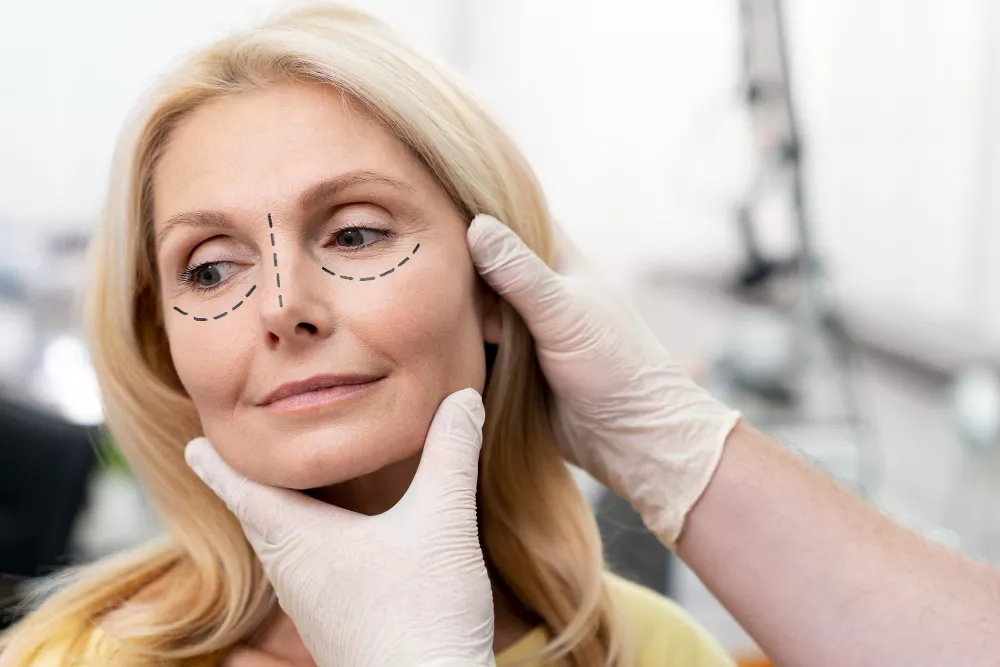What is Transconjunctival Blepharoplasty?
Transconjunctival blepharoplasty, one of the most modern methods used in eyelid aesthetics, is a preferred technique for treating bags under the lower eyelids. In this procedure, the surgical incision is not made through the skin, but through the conjunctiva, the inner part of the eyelid. This leaves no visible scar. It’s a suitable option for individuals with minimal excess skin but noticeable under-eye fat.
The most significant advantages of this technique are its less invasive nature compared to traditional methods, its rapid recovery process, and its shorter return to social life. It’s a procedure that provides natural and aesthetic results, especially for those experiencing bags at a young age.
What is the Difference Between Transconjunctival and Classic Blepharoplasty?
The two most common techniques for eyelid surgery are transconjunctival and classic blepharoplasty. In the classic method, the incision is made through the skin, and excess skin and muscle tissue are also smoothed out. This can help address both bags and sagging. However, even if the incision is hidden within the eyelid crease or lash line, scarring is still possible.
In the transconjunctival technique, the incision is made on the inside of the eyelid. This eliminates any visible scarring. However, this method doesn’t aim to remove excess skin; it only allows for the removal or reshaping of fat pockets. In other words, while classic blepharoplasty is preferred for more extensive issues, transconjunctival blepharoplasty is used in more limited and specific cases.
Both methods are planned based on a personalized assessment. While the transconjunctival method is more suitable for younger patients without sagging skin, the traditional method may be a more appropriate choice for older patients or those with excess skin.
In Which Situations Is Transconjunctival Blepharoplasty Preferred?
This procedure is the most suitable option for individuals who experience bags under their lower eyelids but do not have excess skin. Fat bags, especially those that appear in young adults, can create a tired and aged appearance. For these individuals, simply removing the fat tissue is sufficient, as the skin maintains its elasticity.
It’s also highly advantageous for patients who want a quick recovery and plan to return to their work and social lives quickly. Because there’s no visible incision line after surgery, natural results are achieved. This procedure is also recommended for those with thin eyelids and those concerned about visible scarring.
What Eye Problems Are Treated With This Method?
Transconjunctival blepharoplasty is performed to remove or reshape fat pockets, particularly those found in the lower eyelids. These pockets often develop due to genetic factors or aging. This technique offers an effective solution when under-eye puffiness occurs without sagging skin.
Surgery eliminates under-eye bags, giving a more youthful and youthful appearance. Additionally, the reduction of fat deposits can also alleviate dark circles. A more aesthetically pleasing eye area can be achieved. However, if the skin is sagging, wrinkled, or overly thick, this procedure alone may not be sufficient, and a traditional blepharoplasty may be a more appropriate option.
How is Transconjunctival Blepharoplasty Performed?
Transconjunctival blepharoplasty is a modern and frequently used procedure in cosmetic surgery to remove bags and fat deposits in the lower eyelid. During the procedure, the surgeon makes a small incision on the inner surface of the eyelid, the conjunctiva. Through this incision, excess fat is removed or reshaped, eliminating the appearance of under-eye bags.
Because no incisions are made in the skin, there are no external scars. The surgery typically takes 30-45 minutes. It is usually performed under local anesthesia, but sedation may be preferred in some cases. The patient is discharged the same day and can quickly return to their daily activities.
What distinguishes it from the classic blepharoplasty method is that it’s performed without any skin incisions. This makes it a more suitable option for younger individuals who don’t have sagging skin but have excess fat.
Is Transconjunctival Blepharoplasty Non-Surgical?
While this method is sometimes considered non-surgical because it doesn’t require any incisions, it’s actually a surgical technique. Procedures described as “non-surgical” typically involve fillers, lasers, or similar cosmetic procedures. Transconjunctival blepharoplasty, on the other hand, is based on surgical principles. Because it eliminates any incisions in the skin, it offers a more comfortable procedure.
The patient doesn’t feel any pain during the surgery. Thanks to the anesthesia administered, the procedure is performed safely. Because the postoperative return to social life is quicker, many consider this procedure a more practical option. So, while it may seem nonsurgical, transconjunctival blepharoplasty is a surgical procedure.
How Long Does the Recovery Process Take?
You may experience mild swelling and bruising around your eyes in the first few days after surgery. This is part of the body’s natural healing process. Applying cold compresses , sleeping with your head elevated, and resting regularly, especially in the first 48 hours, can help alleviate symptoms.
Swelling and bruising around the eyes generally disappear significantly within 7-10 days. Most people can return to work or social activities within a week. However, it can take several months for the tissues in the eyelid area to fully heal and the results to become natural. On average, the swelling subsides completely within 1-3 months, and the area around the eyes regains a youthful, smooth appearance.
Factors that affect recovery time include a person’s age, skin type, general health, and post-operative care habits. Following your doctor’s recommendations will ensure a quick and smooth recovery.
Will There Be Any Scars After Transconjunctival Blepharoplasty?
One of the most significant advantages of this method is its scarless results. The surgical incision is made on the inside of the eyelid, not through the skin. This means there will be no visible scar upon completion of the procedure.
You may experience mild redness or swelling in the first few days. These symptoms quickly disappear, and the eye area returns to its natural appearance. The long-term scar-free procedure results in highly aesthetically pleasing results. This procedure is particularly suitable for those concerned about scarring.
Does This Procedure Provide a Permanent Solution?
Fat bags removed or reshaped with transconjunctival blepharoplasty do not reoccur for many years. Therefore, the procedure provides permanent results. However, as the aging process continues around the eyes, sagging skin or new bags may appear in later years.
Surgical results typically last 8-10 years. Lifestyle, genetics, smoking, sun exposure, and sleep patterns all influence this length of time. With regular care and healthy lifestyle habits, results can be maintained even longer.
Is Transconjunctival Blepharoplasty Risky?
As with any surgical procedure, transconjunctival blepharoplasty carries certain risks. However, when performed by experienced surgeons on suitable candidates, it is considered a safe procedure. The most common complications include temporary swelling, bruising, and mild asymmetry. In rare cases, infection, bleeding, or temporary blurred vision may occur. Because no incision is made through the skin, there is no risk of scarring. This makes the procedure more advantageous than traditional blepharoplasty.
The surgeon’s experience, the sterile conditions of the operating room, and the patient’s adherence to postoperative recommendations are crucial in minimizing risks. Properly planned surgeries are highly unlikely to result in serious complications.
Transconjunctival Blepharoplasty Reviews and Patient Experiences
The vast majority of patients who choose this procedure are satisfied with the results. The lack of scarring and the natural reduction of under-eye bags are among the most frequently cited advantages. Many report a more youthful and youthful appearance after surgery.
Another noteworthy aspect of patient experiences is the rapid recovery process. Most patients report returning to their daily lives within a few days and achieving aesthetically pleasing results within a few weeks. However, some patients also report experiencing brief limitations in their social life due to swelling and bruising in the initial days.
When the comments are evaluated in general, it is seen that transconjunctival blepharoplasty is a method that meets expectations, offers natural results and has no scars.
What Should Be Considered After Transconjunctival Blepharoplasty?
There are some important points to consider in the postoperative period. In the first few days, cold compresses may be used to reduce swelling and bruising around the eyes. Keeping the head elevated contributes to the healing process.
It’s important to avoid strenuous activities like sports, saunas, and Turkish baths for at least two weeks. Rubbing your eyes and making sharp movements should be avoided. Wearing sunglasses after surgery to protect yourself from sunlight is highly beneficial. Regular use of eye drops and medications prescribed by your doctor will also speed up recovery.
It’s generally necessary to wait a few weeks before applying makeup. Patients who wear contact lenses are also advised to take a break until they receive approval from their doctor. Regular checkups and following your doctor’s instructions will ensure a smooth transition.
Transconjunctival Blepharoplasty Prices 2025
Transconjunctival blepharoplasty prices in 2025 range between $2,500 and $5,500, depending on the clinic, surgeon, and anesthesia type. This lower eyelid surgery removes or repositions excess fat through the inner eyelid, leaving no external scars and providing a smoother under-eye appearance. Recovery usually takes 1 to 2 weeks, with final results visible after swelling subsides. Costs vary with hospital facilities, geographic location, and whether the procedure is combined with skin tightening treatments. Some clinics may also offer package deals including consultation, surgery, and postoperative care, which can influence the overall cost.
Prices, updated in 2025, are determined based on a personalized evaluation. Therefore, the most accurate information can be provided after the examination. Generally speaking, transconjunctival blepharoplasty is preferred because it takes less time than traditional methods and offers better recovery. Prices may vary depending on the individual’s needs and expectations.
Who is Suitable for Transconjunctival Blepharoplasty?
This technique, performed on the inner side of the eyelid, is particularly suitable for individuals with fat pockets in the lower eyelid but no excess skin. This method successfully addresses these bags, which typically appear in younger individuals. The best results are achieved in patients with good skin elasticity and no wrinkles or sagging. It is also a preferred method for individuals concerned about scarring.
Is This Procedure Painful?
Because local anesthesia or sedation is used during the surgery, the patient doesn’t feel any pain. A slight stinging, tightness, or pressure sensation may occur in the first few days after the procedure. However, this usually subsides within a few days. The procedure can be easily managed with painkillers recommended by your doctor. Overall, it’s a comfortable procedure that can be tolerated even by those with a low pain threshold.
Are stitches required in the transconjunctival method?
With this technique, the incision is made on the inside of the eyelid, so no stitches are placed. The incision in the conjunctiva closes and heals on its own, leaving no scarring. In some cases, thin, dissolvable stitches may be used, but these are unnoticeable and will disappear on their own without needing to be removed.
Can Under-Eye Dark Circles Be Removed?
Bags in the lower eyelids can make under-eye circles more noticeable. Removing or reshaping the fat can help reduce the appearance of dark circles. However, bags aren’t always the cause of dark circles. Genetics, skin thinness, or vascularity can cause dark circles to persist. So, while this method may not completely eliminate them, it can significantly reduce them.
Is Transconjunctival Blepharoplasty Necessary Again?
The results achieved last for many years. However, as the aging process continues, new bags may appear in later years. It is generally not necessary again for 8-10 years. Lifestyle, genetic factors, sun exposure, and smoking can affect this period. Even if a second surgery is necessary, it usually occurs after a longer period.
How Long Does It Take to Return to Work After the Procedure?
Swelling and bruising may occur around the eyes in the first few days after surgery. Therefore, patients are generally advised to rest for 5-7 days. Most people can return to their social and work activities within a week. For faster recovery, it’s important to keep your head elevated, avoid strenuous activity, and follow your doctor’s recommendations. The eye area typically improves significantly within 10 days.
Will Transconjunctival Blepharoplasty Completely Eliminate Under-Eye Bags?
By removing or reshaping the fat pads, lower eyelid bags can be largely eliminated. When performed with the correct technique, permanent and satisfactory results are achieved. However, some individuals may experience sagging skin along with the bags. In such cases, the transconjunctival procedure alone may not be sufficient, and traditional blepharoplasty may be preferred. In other words, this procedure completely eliminates the bags in the appropriate patient group, but each individual evaluation must be made individually.






